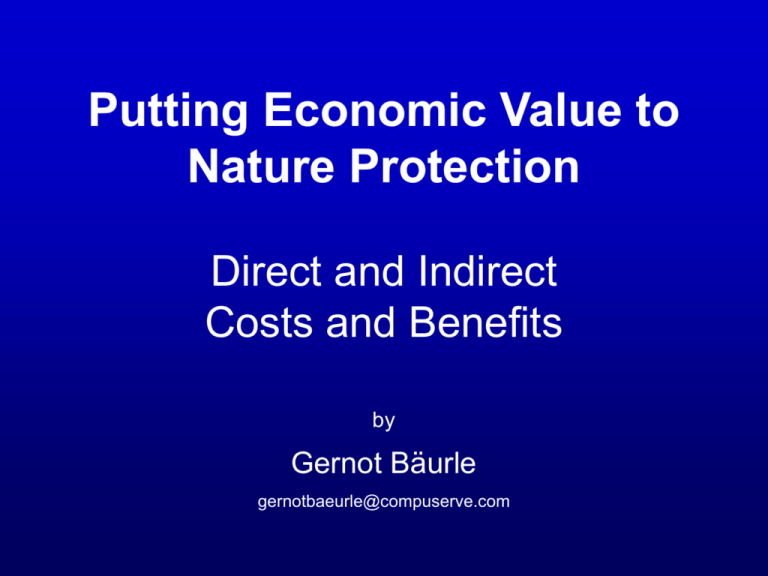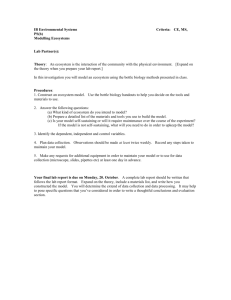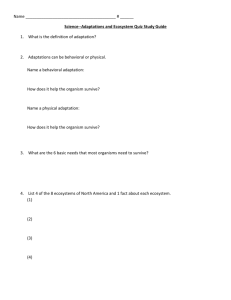direct and indirect costs and benefits
advertisement

Putting Economic Value to Nature Protection Direct and Indirect Costs and Benefits by Gernot Bäurle gernotbaeurle@compuserve.com Presentation Outline • What is the economic value of nature? • How to determine the economic value? • How confident can we be about these value estimates? • Costs & benefits of nature protection: spatial & temporal mismatches • How to reconcile these mismatches? • Payment for ecosystem services • Digression: Conservation Finance Alliance • Conclusions What is the economic value of nature? Use Values Total Economic Value Direct Use Value benefits from consumption Indirect Use Value benefits from ecosystem functions Option Value benefits from availability for possible future use Bequest Value legacy benefits Existence Value existence benefits Non-use Values (OECD 2001, adapted) e.g. agricultural products e.g. hydrological regulation e.g. gene pool e.g. cultural landscape conservation for future generations e.g. knowledge of existence of wildlife diversity How to determine the economic value? Market Price Approach by definition, market values tend to reflect actual use and hence ignore non-use values • Observed market price method • Cost-based Methods - replacement cost - opportunity cost Revealed Preference Approach prices revealed in other (surrogate) markets that are affected by the goods/services to be valued • Travel Cost Method • Hedonic Price Method • Averting Behaviour Method Stated Preference Approach willingness to pay (WTP) estimates used when no (surrogate) market exists (construction of a market) • Contingent Valuation Benefit Transfer values borrowed from existing studies (direct elicitation of WTP) • Choice Modelling (indirect elicitation of WTP) - choice experiments - contingent ranking - contingent rating - paired comparison (OECD 2002, adapted) Levels of Confidence in Estimates Value Confidence direct use values high e.g. for agricultural products indirect use values low – medium e.g. for ecosystem services existence/option values very low – medium e.g. for a landscape (OECD 2001, adapted) Costs and Benefits: Place local national costs benefits (Balmford & Whitten 2003, simplified) global Costs and Benefits: Time present future costs benefits Additional problem: How to compare costs and benefits over time? How to reconcile spatial and temporal mismatches? Payment for Ecosystem Services e.g. erosion control, hydrological regulation through sustainable land use ecosystem catchment area Financial incentive rural population landowners alternative sources of income, compensation for foregone benefits National economy Transfer payments e.g.: •constant water supply •reduction of floods •reduction of siltation of dams Reducion of costs and risks Ecosystem services Protection/restoration of ecosystem services Benefits from ecosystem services private sector, communities, e.g.: •industry •hydropower plants •waterworks economic benefit, e.g.: •lower maintenance costs •lower water treatment costs Payment for Ecosystem Services: example of a tax/levy/surcharge approach Governance Structure Beneficiary €€ ££ ¥¥ $$ Financing Mechanism Payment Mechanism Ecosystem Services (World Bank 2002, adapted) Alternatively a market based approach is possible €€ ££ ¥¥ $$ Land user Conservation Finance Alliance: CF Guide www.guide.conservationfinance.org Conclusions • Economic valuation of nature and nature protection is not an “exact science” • it can be a double edged sword but it can add depth to decision making when trade-offs are necessary • A mismatch of costs and benefits of nature protection over time and space exist Payment for ecosystem services can help to even out this mismatch In the end nature protection is a matter of societal choice and beyond pure economics.






